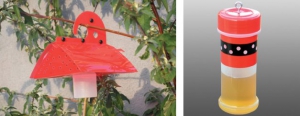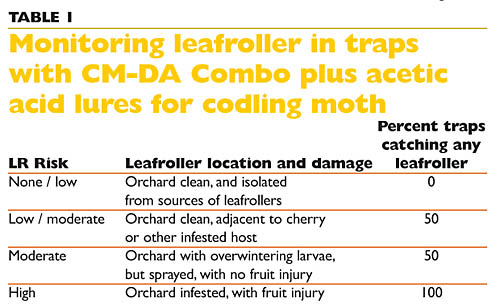
Left: Figure 1. Ajar trap for oriental fruit moth with exclusion holes. Right: Figure 2. Zorro trap for spotted wing drosophila.
PHOTOS BY ALAN KNIGHT
While the broad goal for any trapping program is similar, the specific focus can vary for different pests, such as codling moth, oriental fruit moth, the Pandemis and obliquebanded leafrollers, and spotted wing drosophila.
Codling moth can be adequately monitored with a high-load sex pheromone lure within sex-pheromone-treated orchards, but the combination of sex pheromone and pear ester improves the reliability of monitoring in orchards where mating disruption is used and allows female moth populations to be tracked. However, with oriental fruit moth, sex pheromone lures do not work under mating disruption, and orchards are often still monitored with an open bait bucket.
In the case of leafrollers, pheromone traps often catch too many moths, and catch is not indicative of infestations inside the orchard. Similarly, spotted wing drosophila can be trapped with apple cider vinegar in very high numbers around infested orchards. Farm managers have used a variety of trap designs with little coordination even among researchers or extension specialists to help interpret catch numbers from this ensemble of traps.
Research to develop effective monitoring tools for tree fruits has a long history at the U.S. Department of Agriculture’s Agricultural Research Laboratory in Yakima, Washington. Dr. Frank Howell, who passed away in 2012, was instrumental in the development of the standard wing trap baited first with virgin female moths and then with synthetic sex pheromone lures for codling moth. More recent studies have focused on developing several innovative new monitoring approaches for pests: the use of a single trap to monitor codling moth and leafrollers, a new trap design to monitor both sexes of oriental fruit moth in mating-disruption-treated orchards, and a new trap design for spotted wing drosophila.
One trap for codling moth and leafrollers
Adding acetic acid to the Pherocon CM-DA Combo lure clearly increases catches of male and female codling moths. In response, Trécé, Inc., developed the Pherocon AA lure. Over the past few years, we have noticed low catches of leafrollers in traps placed in some orchards. To address this, we developed a new AA lure that has a much higher release rate to be most effective for leafrollers. A two-year project funded by the Washington Tree Fruit Research Commission with Dr. Jay Brunner at Washington State University and Dr. Rick Hilton at Oregon State University found that, in most cases, catches of leafrollers in these traps were indicative of the presence or risk of infestation of either leafroller (Table 1). However, some exceptions were also noted.

False negatives (traps failed to catch) sometimes occurred when overwintering larvae were found, but no subsequent adults were captured. This was likely due to the subsequent use of insecticides to control the larval population. Another occurrence was when damage in some Medford pear orchards was misidentified as leafroller injury, but was actually caused by eye-spotted bud moth. False positives (traps catch moths but no larvae or injury was detected) also occurred. These instances were due to the presence of adjacent cherry orchards or other known nearby infested hosts.
False positives occurred more frequently in the second half of the season as moth populations dispersed more widely from these sites. The catch of leafroller adults, especially females, emigrating from other sites clearly poses a risk to orchards, and these catches can be an important alert to the farm manager.
Ajar trap for oriental fruit moth
The Ajar trap uses a standard terpinyl acetate plus brown sugar bait as the attractant but not as the catching medium. Instead, the jar of bait is placed inside the delta trap and a sticky liner, like the one used in a standard delta trap (Figure 1), is used to catch moths. The trap has been tested in Europe and South America as well as in orchards on both coasts of the United States. The Ajar trap performs as well as bait-filled bucket traps, catching both sexes of moths and 150 times more total moths than a sex-pheromone-baited trap in one mating-disruption-treated peach orchard in Argentina. Host plant volatiles, such as beta ocimene or beta farnesene, have been added to further increase moth catches. The use of an exclusion screen to eliminate the catch of nontarget moths and hymenopterans and reduce the catch of flies has been developed. These traps will be more fully evaluated by growers in California in 2013.
Zorro trap for spotted wing drosophila
Cherry growers unfortunately rediscovered the wrath of this little fly in 2013. Traps are needed to delineate its geographical distribution and seasonal dynamics in our area. An array of traps is likely needed within and surrounding potential hosts such as cherry and blueberry. Studies are in progress by Dr. Peter Landolt with USDA, Yakima, to develop a more selective lure. Meanwhile, the apple cider vinegar bait works, often too well, with from zero to thousands of flies caught per season per trap.
Growers urgently need a standardized approach to track this pest in its new home. We discovered that flies are strongly attracted to an alternating set of red and black strips. A standard 8-ounce spice bottle was dressed with these colors to become the Zorro trap (Figure 2). The Zorro trap does not catch more flies than all traps tested. But, its simple and effective design offers an opportunity for growers to adopt a standard approach to fight this insidious despoiler of ripening fruit.

Leave A Comment